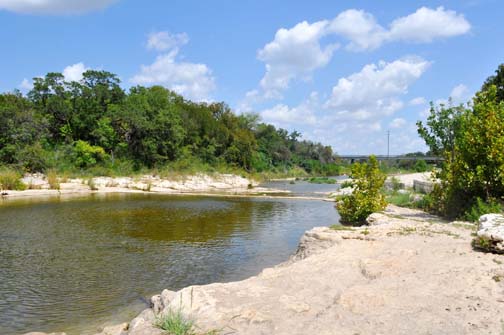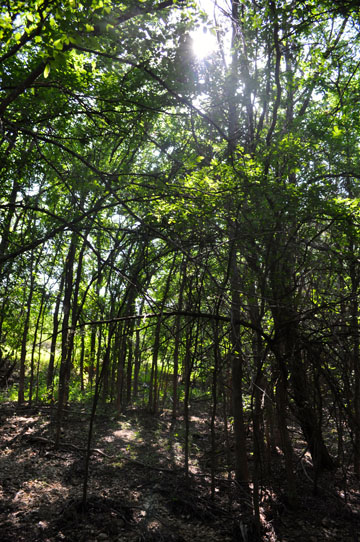|
|

|
|
|

|
|
In stark contrast to Annie's pictures, which were almost exclusively of indoors, and of environments over which she exerted some control via arrangement of material goods, Kati's photographs were all made outside. Her explanations did not focus on control, but rather on a sense of constancy she felt while "in nature." Kati's first set of pictures were made at "Blue Hole" the swimming area a fifteen minute walk from campus. She said her pictures were, "Outside, because outside is what I see at home most often" (Kati). "Home" when she speaks of it refers to Alaska, as she is a transfer student. She spoke at length of how, in Alaska, she finds the most peace and spends most of her time in Alaska. Her seeking out of a similar space indicates that home for her harkens to a place where she is currently not. There is a strong sense of migrancy in this idea of finding home where there is not one. Morley's work focuses on immigrants and migrants. He discusses the ambivalent relationship the migrant has with her new surroundings. He is discussing migrants from other countries, and exiles who were forced to leave their country. Obviously this is fairly different from a young woman who voluntarily chose to move to another state, knowing her purpose there and knowing when she will return. However, she is still out of place, and some of his reflections resonate with her experiences. Morley posits, "Sometimes a particular symbolic object-such as the key to the house from which the refugee has been expelled-is taken on the exile's journey and comes to function as a synecdoche for the unreachable lost home" (Morley 44). He gives the example of the prominent display of a suitcase to symbolize a desire to return home, or to imply that the traveler never really left home. In Kati's case her talisman is not an object at all, but rather a specific view of certain places. None of her photographs were of people or things. Rather, they marked a distinct absence of human presence. In one picture at the Blue Hole people are seen, but in the background. The scene is purposefully shot in a way that focuses on the grass, water, and sky. She says she seeks, "Places that were less crowded, less filled with people" (Kati). However, people are implicitly present in these photographs. Blue Hole is primarily a social space. It is a manmade place designed to cater to human interaction. The swimming area is lined with large rocks, barbecue pits, and there is a public bathroom. People typically go there to interact with others. It is not, speaking from personal experience, a very aesthetically pleasing space, and certainly is more of a conduit for social interaction. Kati's photographs purposefully repressed that aspect, construing it as a "natural" place. This is reminiscent of Annie's photograph of the field, the place she identified as "nature." This, too, was a man made place that she utilized for her purposes of escape. |


|
This disconnect between what Blue Hole usually looks like and how Kati pictures highlights photography's ability to naturalize the subject. Photography often has an assumed truth claim; unlike painting or drawing, it gives a close and immediate approximation of what the eye sees at any given moment. However, as John Berger, photo writer, states, "the photographer chooses the event he photographs. This choice can be thought of as a cultural construction. The space for this construction is, as it were, cleared by his rejection of what he did not choose to photograph. The construction is his reading of the event which is in front of his eyes" (Berger 93). That is to say, a photograph is an interpretation on the part of the photographer. All of the photographs must be considered as an interpretation. In Katie's use of Blue Hole, I could infer that this is a place she visited with friends, yet they were not emphasized. Places are a fluid thing of ambiguous identity that those with the autonomy to do so can construct into something for their own purposes. Also of interest was that, while Annie identified home with a constant that she could seek out daily, Katie said that she only visited Blue Hole about once a month. The emphasis on frequency was much smaller. In addition to repressing the presence of people in Blue Hole, Kati repressed its less aesthetic values, choosing to focus on the vague resemblance it did have to Alaska. She expressed this openly with, "It's a pretty place, but it doesn't compare (to Alaska) so it reminds me of home even more, and then I get homesick" (Kati). Home is very much bound up in a place's correspondence with an ideal of "home" that she holds in her mind. She subverted the inconsistencies by focusing not on things she had control over, such as her room or a living area, but natural constants. When asked what she did at Blue Hole that created such strong associations with it in her mind, she replied, "Sit in the sun. The sun is something I always look forward to no matter where I am. The sun is always the same, even in Alaska, so it's a constant" (Kati). Her emphasis on the sun, explicitly in the photographs of it and implicitly in the fact that all of the pictures are shot during the daytime and are very bright and colorful, serves as a punctum. The sun breaks through the stadium of the rest of the world and becomes a way for her to feel at home. |

|
She also focused on other details of the environment. This focus on detail allows her to repress larger parts of the picture that would not correspond with her idea of home, and also suggests more punctums. Many of her pictures were macro-shots of flowers. She explained, "I really like flowers, and there are a lot of wildflowers in Alaska... There's a lot around my house, and as you're driving" (Kati). Again, home is that which corresponds to a precedent. Morley says of people predisposed to travel, "However mobile people become, some sense of home often remains as the "sacred" or central location, from which they still map and measure their advances and travels" (Morley 40). Though Kati has left Alaska, she still holds it as her home, a "sacred" place. The idea of identification of home through similarity continued in the next set of photographs, though this time they were linked to a routine of hers-namely walking and jogging. It is important to note that, in contrast to Annie, Kati does not have a car, so her independent mobility is limited to her feet. She made several photographs of an area where she frequently walks and jogs. When asked if she frequently saw people here, or walked here with others, she laughed and said, "No, when I jog at home, I don't usually see people... This reminds me more of jogging at home" (Katie). Again, there is a lack of emphasis on people. When specifically asked whether she considered including people, she explained, "I always tend to go more towards nature, because that's everywhere, so I can always find a part of home everywhere-people change" (Kati). Whereas Annie's responses were marked by a sense of constancy that she could control through construction, Katie's were marked by a sense of constancy that she could find in an existing environment. Again, though, it is necessary to emphasize that Katie also constructs her environment through a repression of factors that do not correspond to her idea of what is home. This jogging path is impossible to walk down without seeing the baseball fields and then the cemetery, but neither of these things were pictured. Again, points of focus were details such as flowers. Of interest is that Kati, who clearly feels a distance from "home" did not include any artifacts of home. She is an amateur photographer, and mentioned that, "Even in Alaska, I take pictures outside." In a reversal from the usual use of photographs to act as evocative artifacts, Kati creates photographs similar to the ones she creates at home, thereby using the camera's ability to capture things that look like home as a "suitcase" talisman. However, the camera is a material good with a market value. Kati most likely does not see it as such, since she uses it so regularly and with such purpose. As Epp writes, people, "bring them (goods) into our lives, and give them personal meanings that may strip them of commodity status" (Epp 820). By giving her camera personal meaning, it is no longer a commodity. Since Kati had repeatedly referred to Alaska as "home" I asked if it still felt like home when she made returns from college. She responded that it still felt like home, though she was coming to see Texas as home. She then corrected this, specifying that "Southwestern" felt like home. This separation marks Southwestern as a punctum for Kati within the larger studium of Georgetown, and even Texas. On another level, as with the focus on flowers in an otherwise not-so-aesthetically-pleasing trail, the specification of Southwestern as something somehow outside of and apart from Texas reveals a sort of repression. She then emphasized that Alaska would "always be home" (Kati). |

|
Click to return to the navigation page. |
Sources:
Berger, John, and Jean Mohr. Another Way of Telling. New York: Pantheon, 1982. Print.
Epp, Amber M., and Linda L. Price. "The Storied Life of Singularized Objects: Forces of Agency and Network Transformation." Journal of Consumer Research (2009). Print.
Morley, David. Home Territories: Media, Mobility and Identity. London: Routledge, 2000. Print.